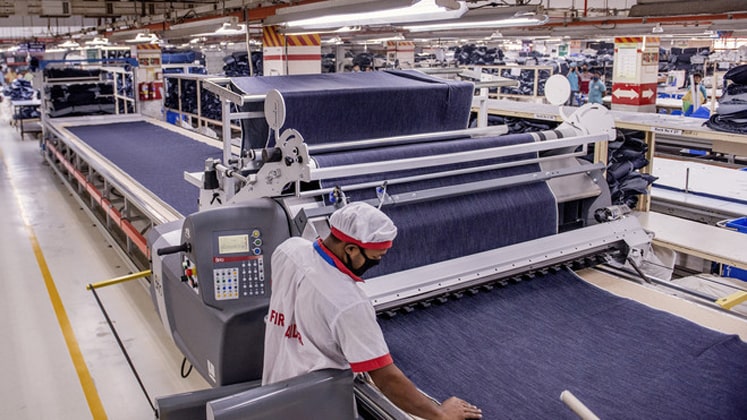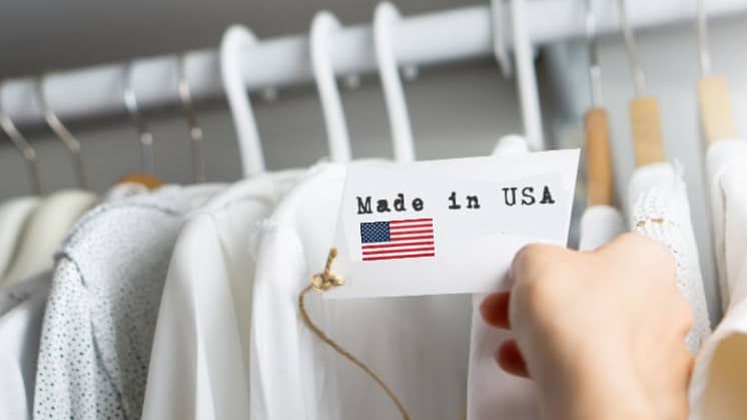Over the last decade, more and more American fashion retailers have wanted to bring back apparel manufacturing to the US; patriotism for ‘Made in USA’ and increasing unemployment have been the main drivers. However, the pandemic-induced disruptions and challenges have accelerated the thoughts and made the Americans realise why onshore apparel manufacturing is the need of the hour for the country.
Before delving deep into how 2021 could give a new dimension to America’s call for reshoring, let us take a quick look at the ground realities already discussed in an earlier feature – The Reshoring Story! Apparel manufacturing is on its way to coming back to the US – done in 2020. The feature highlighted some key developments and setbacks that give direction to the movement:
- Textile manufacturing on the increase, though apparel production continues to fall over the last decade:While the output of the US textile manufacturing totalled US $ 18.79 billion in 2019 (24 per cent jump from what it was in 2009), the apparel manufacturing fell to US $ 9.5 billion (4.4 per cent fall from last 10 years).
- How to increase employment opportunities is a concern:The Reshoring Initiative’s 2018 data report distinctly stated that the reshoring and related FDI together totalled over 145,000 jobs in 2018. This brings the total number of announced manufacturing jobs brought to the US from offshore to over 757,000 since the manufacturing employment low of 2010. Ironically, textile manufacturing jobs slumped by 45 per cent from January 2005 to January 2020, while the fall was 8.7 per cent from January 2020 to September 2020. Similarly, apparel manufacturing jobs fell by 60.3 per cent from January 2005 to January 2020.
- New administration routing for ‘Made in America’:Biden launched a plan in September 2020 that pledged quite a few incentives across different categories – with a focus on revitalising those factories that are shut. In his campaign before the recent elections, he listed a ‘Made in America’ tax credit for companies that bring back jobs from China.
- Retailers’ strategies for re-shoring:Walmart announced its commitment to increase its American-made purchases by US $ 50 billion annually by 2023. Walmart’s US $ 250 billion US manufacturing programme aims at bringing back at least 250,000 manufacturing jobs to the country.
- Recovery of US domestic sector:Recovery of American domestic sector has been instrumental in helping end apparel trade deficit that would further bring down the entire trade deficit by US $ 120 billion annually (25 per cent of the total) thereby creating 1 million manufacturing jobs in the country.
What has changed in 2021!

With this backdrop, it is interesting to note that in 2021, there has been acceleration in the demand for apparel reshoring! In fact, by the end of last year, around 60 per cent of reshoring cases mentioned Coronavirus as one of the major factors causing them to reshore. Some of these cases were related to pandemic-related products, such as masks, gowns, ventilators and more.
The China factor has moved beyond just cost
When the pandemic first reached the US last year, about half of the world’s disposable masks were made in China, but as COVID-19 became a global crisis, face masks became essential and countries started imposing restrictions on exports – consequently leading to shortage of masks and raw materials. In a short span of time, the deadly pandemic had educated the US that it just cannot afford to be too reliant on China. It had to work on ‘Made in America’ policy again. There were no two ways about it.
Here it is imperative to state that textiles and apparels ‘Made in the USA’ are growing particularly fast in some product categories that are high-tech driven, such as medical textiles, protective clothing, specialty and industrial fabrics, and non-woven.
Americans are clear that they can no longer depend on China. One cannot deny that increase in wages in China has been playing a huge role in influencing America to bring back jobs to the US. Back in 2020 and during pre-pandemic times, it was mainly the trade war that caused friction; however, since the start of 2021, the animosity towards China seems to be on the rise for multiple reasons which will continue to push production back into the US.
Increasing wages in China have course been at the background of moving beyond China for some time now. The Chinese wages have been rising significantly over the last decade. In fact, in 2013, it rose by 10 per cent in labour cost and since then has been increasing at a faster pace – sadly, the quality, on the other hand, has not been increasing at the same pace. And that’s worrying! In last 20 years – ever since manufacturing completely left US – wages for Chinese workers have increased by 8 times. It wouldn’t be an exaggeration to say cheap labour and cheap land no longer exists in China. Yes, infrastructure is still huge in China, but fast-rising prices are pushing several companies away from China. The entire reason why manufacturing left America for China years ago seems to have been defeated.
Also, China is geographically distant from major American and European consumer markets. It has been made clear in recent times that companies that are currently manufacturing in China have been constantly facing supply chain risks, thereby affecting customer service. Notably, offshoring costs are rising due to higher wages of factory workers in China. Any tariffs, if and when imposed by Biden Government, is also going to impact sourcing from China. Another reason why manufacturing has been moving from China to the US is the loss of intellectual property through theft. Sadly, goods produced by American firms have lost significant percentages of their market share due to Chinese imitations that have made their way to consumers.
Automation is the key…
Automation and robotics, is indeed the key to offset labour costs, and here one cannot deny the fact that machine learning, artificial intelligence, cloud computing, 3D printing and supply chain management are also instrumental in the continual efforts to reshore manufacturing.
Substantiating on the same, Harry Moser, Founder and President, Reshoring Initiative, says manufacturing costs in the US are often 20 per cent higher than those in Europe and 40 per cent higher than in China and other low labour cost countries. “If we don’t invest in automation, we don’t increase our competitiveness,” he added.
It is difficult for labour-intensive industries, such as apparels and footwear, to return to the US (where labour costs are comparatively high) without being able to make their required profitability margins. It is here that the apparel and footwear firms will have think and talk technology, as only automated manufacturing technologies will help them successfully work out ‘local to local’ production more efficiently and successfully.
A better planning and huge investment in technology will make the process easier but then there’s also fear amongst some workers – fear of losing jobs. Harry corroborates, “Some people are afraid of automation because they’ll lose their jobs.” While stating that workers need to get over that mindset, Harry adds, “The US will lose more jobs to Chinese automation if we don’t automate than we will to US automation if we do. Since we are competing, you have to automate the best you can just to stay even.”

The good part is that lot of companies have gradually started embracing automation. According to the Association for Advancing Automation, orders of industrial robots in North America have jumped by 20 per cent year-over-year (Y-o-Y) in the first quarter to reach 9,098 units. Orders did fall nearly 9 per cent from the fourth quarter of 2020, but still that’s a notable jump.
Automotive OEMs and component suppliers remained the largest buyers of industrial robots at 2,147 and 2,448 unit orders, respectively. A recent survey by Honeywell of employees at companies that directly manage warehouses or distribution centres found that 51 per cent of them were willing to invest in automation as a result of the pandemic. That’s again a good news!
Automation is only going to help further drive the cost targets, quality targets and safety targets that manufacturers have. As of September 2020, US textile production had resumed about 90 per cent of its production capacity at the pre-Covid level. The value of US apparel production in Q3 of 2020 was even 2.2 per cent higher than in Q3 of 2019. Investment to technology is indeed integral to bringing back manufacturing to the US.
But job creation is essential too!
So, while technology is integral to bringing reshoring back to the US, it is also important that enough job opportunities are created. Also, one has to remember technology does not put people out of jobs, but it arms them with the right tools so as to enhance their efficiency and productivity.
It is imperative to state here that compatible with the production patterns, employment in the American textile sector and apparel industry fell to the bottom in April-May 2020 owing to the pandemic, though both the sectors started recovering steadily since June 2020. In fact, from January 2020 to January 2021, the total employment in the two sectors fell by 8.6 per cent and 13.2 per cent, respectively.
Notably, even before the pandemic onslaught – as production turned more automated and thanks to improved productivity (i.e., the value of output per worker) – US textile and apparel factories were hiring fewer workers. The downward trend in employment is not changing for the US textile and apparel manufacturing sector. It is important to mention here that reshoring and foreign direct investment (FDI) job announcements for 2020 were 160,649, bringing the total jobs announced since 2010 to over 1 million (1,057,054).
To reshore more jobs, Harry avers he would like to see the US, Canada and Mexico join hands more on trade matters. He adds, “The US trade agreement with Mexico and Canada (USMCA) is a good start; it may bring back 50,000 manufacturing jobs, which is not a lot. We would like to see the US, Mexico, and Canada come together to bring back 2 million manufacturing jobs from Asia.” That will be more jobs for the people in the US.
And till that happens, the US can work on fulfilling its critical need for more qualified and trained workers to enhance the country’s capacity to reshore, and also continue increasing productivity so as to be more price-competitive with comparatively low wages overseas. One cannot deny that modern products require high degree of specialisation or skilled labour, and scaling up production requires unique skills. The process includes setting up the supply chain for all with regard to the raw materials, designing an assembly process with the appropriate tooling and fixtures, building or securing test equipment, establishing testing and quality procedures and working through materials handling.
Meanwhile, the Reshoring Institute has said it anticipates 2021 reshoring + FDI job announcements to be near 200,000, up by at least 25 per cent. President Biden is today prioritising reshoring highly but applying different methods than President Trump. The gaps in Biden’s plans need to be addressed so as to achieve his Government’s aim of bringing back 5 million more jobs.
COVID-19 has certainly taught the Americans that reshoring will be the biggest growth driver for its manufacturing industry – in particular apparel and textile sector – in next 3 to 4 years. Also, only those firms that explore the opportunity and blend their marketing and selling strategies into the digital space will reap rich dividends and win the race.







